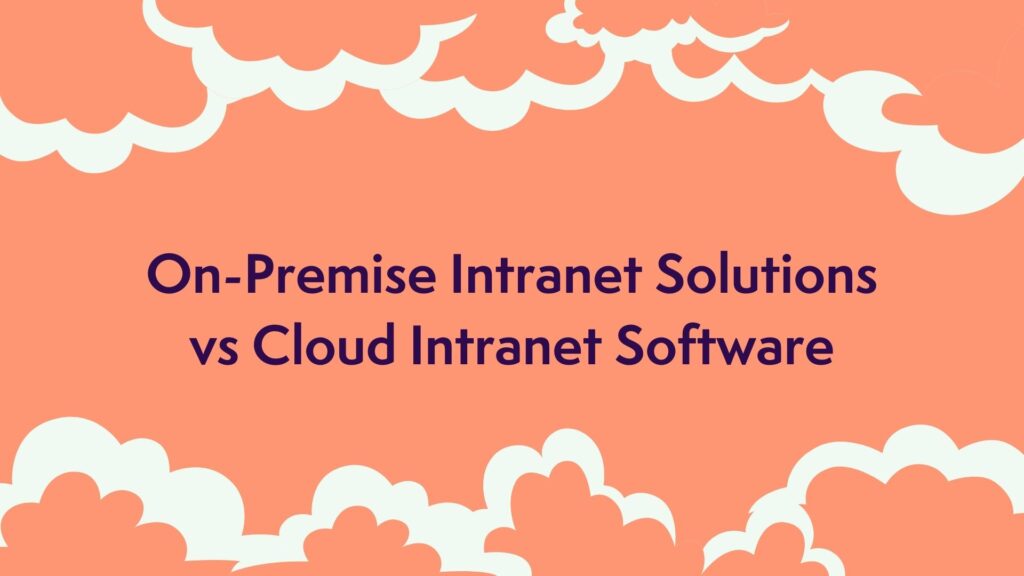Cloud intranet applications have a lot of benefits, but which one is superior: cloud apps or on-premise solutions?
Cloud technology has changed the world by making it possible for businesses to operate without a central office or a server infrastructure. This opens up countless possibilities for organizations with remote employees and frontline workers.
The fact is, choosing between on-premise intranet software and cloud intranet software is a big decision, and one isn’t necessarily “better” than the other. It really boils down to what your organization needs and how it’s structured.
Both options have their own sets of pros and cons, and while cloud intranet software may be preferable for one business, on-premise software might be a better fit for another.
Deciding between the two requires you to consider many factors that could have both positive and negative influences on your organization. Fortunately, outlining the pros and cons can be easy. It’ll help you choose the right intranet software solution for your business.
Table of Contents
What is on-premise intranet software?
An intranet is a private network within an organization that allows employees to communicate, collaborate, and share resources securely. When we talk about on-premise intranet software specifically, it is an intranet solution that is hosted and maintained on an organization’s own servers, within their physical premises, rather than on cloud servers.
This means heightened security and complete control over data privacy. Hence, on-premise solutions are the preferred option for many businesses, including:
- Large enterprises with established IT infrastructures
- Organizations in regulated industries, like banking, healthcare, and government
- Companies with specific data handling and privacy requirements
The Pros of On-Premise Intranet Software
There are many reasons why you might want to host your intranet software on-site, some of which may be more beneficial to your business than others.
Consider the following:
- Improved Security — Security is important for everyone. While today’s top cloud applications are protected with encryption, two factor authenitcation and audits, there’s no denying that on-premise hosting is the strongest option for security, because because everything is under your control and you can make it less accessible to hackers or other forms of intruders. Especially for organizations in highly regulated industries that need to ensure that their data never leaves their jurisdiction, on-premise solutions offer this guarantee.
- More Control — One reason to choose on-premise over the cloud is the ability to have ownership over the platform. While subscription and maintenance charges in the 20%-25% range are typically still in place, the fact that a business actually owns a piece of software holds a lot of weight for many higher-ups and security-focused IT professionals. Plus, organizations have the autonomy to schedule updates and backups based on their convenience and operational requirements. This autonomy ensures that updates or changes don’t interfere with ongoing tasks or disrupt operations.
- In-Depth Customization — The ability to customize software so it fits your business can make a huge difference in terms of how beneficial it is. When you host your own flexible intranet software, options for collaboration open up in ways that aren’t possible otherwise. And sometimes these options require you to customize certain aspects to make them even more efficient. This is perhaps the number one reason to consider on-premise.
- Integration of Current Processes — For intranet software to truly work well for your company, it’s important to properly integrate your current business processes. When you purchase software-as-a-service (SaaS), integration can occasionally be limited depending on the vendor you choose. When you host your social intranet platform, integration typically becomes far easier and more streamlined.
The Cons of On-Premise Intranet Software
The benefits of on-premise software don’t come without their corresponding set of detractions, some of which can be deal-breakers.
Here are a few “cons” to keep in mind if you’re considering this route:
- Up-Front Costs — Cost can be a huge issue, and one of the most difficult aspects of setting up on-premise software is that it can be more expensive. Unlike SaaS or cloud intranet software, on-premise software usually comes with up-front costs; think hardware, space, licensing fees, etc. For young businesses, these and other associated costs can make on-premise software out of reach.
- Scalability — While cloud solutions offer the flexibility to scale resources on-demand, on-premise setups often necessitate additional hardware purchases to accommodate growth. The need for dedicated physical space for servers and related infrastructure can pose limitations, especially for businesses with spatial constraints or those experiencing rapid expansion.
- Possible Limited Mobile Access — Mobile access to software is becoming more and more important as time goes on and smartphones and tablets become more fully integrated into the business landscape. When working with on-premise software, it’s not always possible to log into a mobile intranet the way you might if you had cloud software. Believe it or not, I’ve recently talked to a few companies that still (even today) don’t allow remote workers to access software on their internal network … or they make it highly difficult to do so, requiring you to jump through the VPN hurdles. It may not seem like a big deal at first, but this issue can severely limit functionality for those constantly on the go.
- Lack of IT Support — As you might expect, it’s not uncommon to run into issues when using a new piece of software. IT support can be extremely helpful in this regard, and you’re far more likely to have access to support if you’re working with cloud intranet software than the alternative. Add to this the fact that you might need to pay extra to hire internal IT professionals, and on-premise software looks less and less attractive.
- Lack of Automatic Updates — While having complete control over updates can be seen as a benefit for on-premise solutions, it has its downsides. Unlike cloud systems that get regular and automatic upgrades from the vendor, on-premise systems might miss out on the latest features or security patches.
- Disaster Recovery — Organizations must have mechanisms in place to restore data and ensure system continuity in case of unforeseen events like hardware failures, data breaches, or natural disasters. Setting up these disaster recovery solutions can indeed be intricate, requiring both technical expertise and significant investment.
The Pros of Cloud Intranet Software
The cloud is becoming more crucial an aspect of the professional world every day, and cloud-based software solutions are increasing in popularity among organizations of all kinds.
Here are a few “pros” associated with cloud intranet software options:
- Cost Savings — Cloud intranet software can end up costing your business less than the alternative. Contrary to on-premise solutions, cloud options mean you don’t need to spend money on hardware and other associated costs, which can add up to thousands of dollars per year.
- Remote-Friendly — One of the most beneficial reasons to consider intranet software in the first place is the ability to improve how your business operates remotely. When you’re managing remote employees, you’ve got to know they’ll have little difficulty getting things done. Cloud intranets make remote working a breeze, which can’t always be said for on-premises solutions (although there are plenty of options out there that focus on improved remote workflow).
- Improved IT — When you purchase a cloud intranet from a reputable software vendor, you can usually rely on having high-quality IT support. The ability to get in touch with those who actually designed the software is worth its weight in gold, especially when you’re in the middle of a project and need help immediately.
- Seamless Updates — With cloud intranet solutions, you can ensure that any updates your vendor is making to the software will be rolled out quickly and effectively. On-premises software doesn’t usually offer this benefit as it usually requires you to upgrade yourself.
The Cons of Cloud Intranet Software
Even though cloud intranet software may seem like the perfect solution for your business, it also has its cons, including:
- Lack of Control — More often than not, businesses pay a monthly fee when using a cloud intranet. In many ways, you’re paying for the lowest common denominator of features that will work for all users of the cloud system. While this isn’t necessarily a bad thing, some people prefer the idea of having more control rather than being at the mercy of the vendor.
- Configuration vs. Heavy Customization — Customization can have a massive impact on how functional intranet software is for your organization. Cloud intranets are more easily “configured” than they are fully “customized,” especially when it comes to the one-size-fits-all intranets that seem to pop up every day. While there are many vendors that offer strong customization in the cloud, this aspect is typically more in line with on-premise options.
- Less Control Over Systems/Data — When you’re working with an on-premise platform, systems and data are in your full control. With cloud intranet software, however, vendors are usually the ones taking the reins in this regard. Normally, this isn’t an issue for most businesses. For some though, the lack of control can create a feeling of discomfort. Who owns the data? Who’s looking at your data? Can you take your data with you?
The Bottom Line
Choosing between cloud intranet software and on-premise solutions is easier said than done, and sometimes it comes down to the type of organization using the software.
Young, fast-growing businesses stand to benefit more from cloud intranets, given the lack of high up-front costs.
Established companies that are looking to have more control and expand upon their platform may benefit from on-premise software, as it opens up other options that are limited when using cloud intranet software.
In the end, the decision you make should be based on the factors listed above, each of which can have either positive or negative effects on your business.
Take a moment to weigh the pros and cons, and you’ll no doubt find the solution that is right for your organization.










